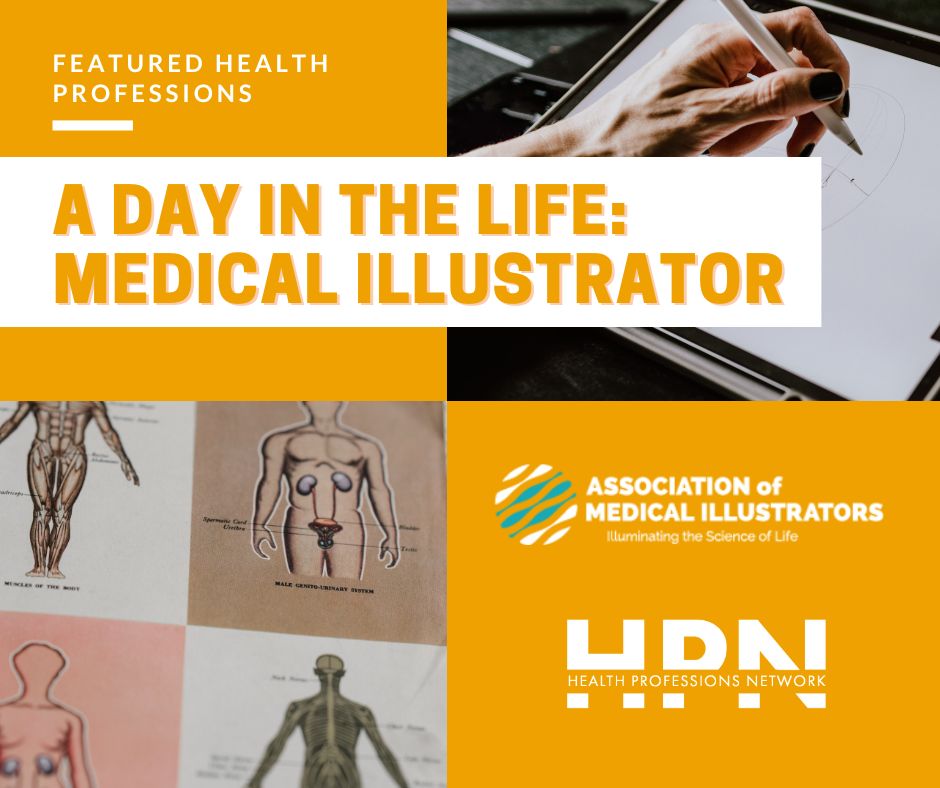A crucial role for furthering public health literacy and medical education, the medical illustrator is a visual storyteller that impacts healthcare with art. Medical illustrators have played a key role in the advancement of medical science throughout the history of medicine, and continue to be relevant today beyond the two-dimensional—building 3D models, and virtual and interactive experiences.
This blog is part of a series of profiles of different clinical health professions represented by Health Professions Network member organizations. These profiles are intended to give students and those looking at prospective careers in health care an accurate, professional perspective on different health care fields, specialties and careers. "A Day in the Life of a Medical Illustrator" was developed by the Association of Medical Ilustrators, or AMI, an HPN member organization.
Table of Contents
- What is a Medical Illustrator?
- The Medical Illustrator's Work Environment
- Goals and Rewards of Being a Medical Illustrator
- Becoming a Medical Illustrator
- Salary, Job Outlook & Professional Resources for Medical Illustrators

What is a Medical Illustrator?
A medical illustrator / animator is a visual storyteller creating images that teach and illuminate science. Their imagery increases public health literacy, enhances medical education, and facilitates research and communication of scientific discovery.
As a professional artist with extensive training in medicine, science, communication, and technology, a medical illustrator is uniquely suited to grasp complex information, distill it down, and create an accurate and engaging visual narrative that communicates to its target audience.
The result of a medical illustrator’s work may be 2-D illustration for print or web, 2-D or 3-D animation, AR/VR apps, simulation, educational games, exhibits, demonstrative evidence for legal proceedings, curricular content, 3-D models, prosthetics, or an interactive experience. Medical illustrators work in a range of markets including publishing, education, advertising, research, law, and technology.
A medical illustrator / animator may work on their own or as part of a team that may also include developers, UX designers, subject-matter experts, medical writers, video production specialists, and other creative professionals.
Most medical illustration projects begin with research and a review of relevant peer-reviewed literature. Often a conversation with a physician, scientist, or other subject-matter experts is involved as well. Reference material is gathered, which may include observing surgery, obtaining DICOM images or laboratory data, or downloading Protein Data Bank structural models or CAD files of a device.
The next steps of the process vary depending on the topic and the desired result, but often research is followed by sketches or storyboards that are reviewed by project stakeholders or subject-matter experts before proceeding with the final art, animation, or interactive product.
The majority of medical illustration and animation today is completed in a digital format with sketches / models initiated directly on a computer using a pressure-sensitive tablet or sketches on paper being scanned into the computer and the remainder of the project rendered digitally. Many projects allow for artistic license, creativity, and varying approaches to storytelling, but in all cases scientific accuracy is required.

The Medical Illustrator's Work Environment
Medical illustrators may be self-employed or employed by the government, private companies, educational institutions, or non-profit organizations. Employers include publishing companies, medical or veterinary schools, hospitals, science communication companies, and medical-legal companies.
Medical illustrators may work alone or in groups or departments. An experienced medical illustrator may lead a team of creatives, direct a biomedical communications department, teach, or start their own company. Advanced medical illustrators often function as content developers, creative directors, consultants, and administrators.
With a unique combination of medical and scientific knowledge, artistic talent, and communication skills, medical illustrators are poised to be strong leaders and successful liaisons between creatives, scientists, healthcare providers, and business people.
In fact, a growing number of medical animators work in research labs analyzing and modeling research data and molecular interactions to guide the data-exploration process as the scientific story is unfolding. Interdisciplinary knowledge in biochemistry, genomics, and computational molecular biology enable this close interaction and blur the lines between scientist and artist.
Goals and Rewards of Being a Medical Illustrator
Patient interaction and support is a significant reward of being a medical illustrator. Nowhere are medical illustrators more valued than in patient education and health literacy. Images can transcend medical jargon and explain concepts more clearly than words alone.
Enabling patients to understand what is happening to their bodies, process the risks and benefits of treatments, and then make health decisions is the crux of informed consent. Plain language writing and graphical figure design work together.
Medical illustrators apply their training in visual learning, dual coding, and cognitive load theory of multimedia to design audience-appropriate images and animations. They may also conduct user testing to evaluate and refine content for patients and the public.
Also, medical illustrators make meaningful contributions to quality care. Medical illustrators help educate the next generation of healthcare professionals while also enhancing the continuing education of practicing physicians.
Visualizations help scientists communicate their discoveries with each other and the world, and sometimes even contribute to new discoveries directly by displaying data or structures in novel ways for exploration and investigation.
Medical illustrators improve health literacy and demystify complicated information which can lead to improved vaccination rates, for example.

Becoming a Medical Illustrator
People approach the career of medical illustration from a number of different directions, and there are various educational paths to a degree. People typically start their journey in high school and move on to bachelor and then graduate studies.
Students enter medical illustration graduate programs via a variety of undergraduate educational pathways focusing on art and science/biology. During undergraduate studies, students should concentrate on these two areas:
- Science preparation: include courses in introductory biology, vertebrate anatomy, physiology, and cell or molecular biology. The science courses must be of the caliber required for science majors. Additional coursework may include chemistry, developmental biology, zoology, molecular biology, histology, biochemistry, immunology, embryology, pharmacology, genetics, or neuroscience.
- Visual art preparation: including drawing from direct observation (still life studies), figure drawing from life, portraiture from life, painting, color theory, graphic design, illustration, and digital media (raster or vector software). Additional coursework may include field sketching, sequential illustration, 3D modeling, 2D or 3D animation and web/interactive design.
Some undergraduate schools offer minors or majors in scientific, biological, or life science visualization that teach foundational skills in creating images based on research, observation, and realistic depiction methods required for this career path.
A terminal degree in medical illustration is at the Master’s level. Only a handful of universities offer graduate degree programs and acceptance into these programs is very competitive. A list of graduate programs, including 4 programs accredited by CAAHEP and endorsed by the Association of Medical Illustrators, can be viewed on ami.org.
- Course work varies from program to program, but all include an advanced course in human anatomy with dissection and may include a combination of other biomedical science courses such as embryology, histology, neuroanatomy, cell biology, molecular biology, biochemistry, physiology, pathology, immunology, pharmacology or genetics, along with specialized applied art courses such as surgical and/or medical-legal illustration. Other classes may include learning and instructional design, interactive media development, data visualization, molecular visualization, graphic medicine, 3-D modeling and animation, along with traditional drawing and computer applications.
- Programs require master's thesis or research projects and may have optional courses available in specialty fields such as advanced interactive media studies, forensic illustration, or patient prosthetics.
Some medical illustrators come to the profession having achieved doctoral degrees in related fields of science or education or having professional standing as a physician or research scientist. Graduate programs are sometimes an option for these individuals, but there are also post-graduate programs and certificates.
Are there Clinical Requirements to Become a Medical Illustrator?
There are no license requirements to practice medical illustration. However, the nature of the profession demands that practitioners continue to keep up with new developments in both science and communications media. There is an optional certification program offered by the Board of Certification of the Medical Illustrator, leading to a Certified Medical Illustrator (CMI) credential. CMI is conferred by passing a written test and portfolio review. The CMI is renewable every 5-years by completing a number of continuing education credits.

Salary, Job Outlook & Professional Resources for Medical Illustrators
The U.S. Bureau of Labor Statistics lumps medical and scientific illustrators in with other fine artists. These artists and related workers made an average salary of $65,800 in 2020, according to the BLS.
Because they have more specialized skills, however, medical illustrators earn more than typical fine artists. For example, the Association of Medical Illustrators survey data show the median salary for medical illustrators / animators is $75,594 in 2021 and can range up to $185,107.
Those with interdisciplinary skills in UX design who create apps and AR / VR experiences are in demand and earn a median salary of $80,120 – $104,858 in 2021.
Adept professionals who advance their role to art director or creative director earn a median salary of between $95,228 and $130,537 in 2021.
As in all creative industries, earnings vary depending on experience, artistic talent, type of employer, proficiency in visualization media, and business savvy.
Job availability and projections
Health and science visualization are in demand to keep pace with new discoveries, treatments, and technologies. Not surprisingly, then, the employment outlook for medical illustrators is excellent.
As is the case with most other artists, the more impressive a medical illustrator’s portfolio, the more jobs they will be able to get. About a third of medical illustrators are self-employed and operate their own business. Another third are salaried with staff positions, and a third have salary jobs plus work freelance on the side.
Professional resources and organizations
The Association of Medical Illustrators (AMI) is an international non-profit founded in 1945 and is comprised of over 800 members across 4 continents. The AMI furthers the use of visual media to advance life sciences, medicine, and healthcare through a worldwide network of specialized interdisciplinary professionals. The AMI is recognized as the premier global resource for promoting the power of visual media to advance scientific understanding, communication, education, and research. The AMI is a key partner in the process of scientific discovery, knowledge transfer, and innovation.
The Association of Medical Illustrators
- promotes the highest levels of competency, professionalism, and ethics among our members and throughout our community of industry partners
- cultivates collaboration within a global network of colleagues who can contribute to our mission
- serves society as visual translators between the expert and novice, the scholar and student, the physician and patient
For more information about the Association of Medical Illustrators, visit ami.org or email hq@ami.org.

